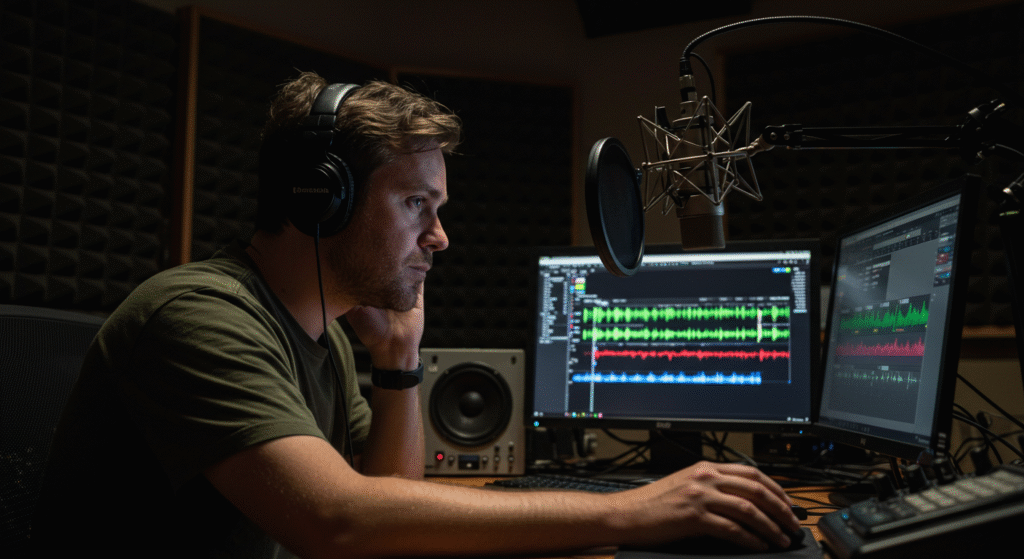Whether you’re auditioning for an animated series, narrating an audiobook, or stepping into the booth for a thirty-second commercial, your voice must do far more than read lines—it has to captivate, persuade, and paint entire worlds in the listener’s imagination.
Two pillars make that possible: a flexible vocal range and crystal-clear diction. Range lets you jump from a booming villain to a timid child without missing a beat, while diction ensures every syllable lands cleanly in the producer’s waveform.
In the guide that follows, you’ll discover a complete training blueprint—breathing foundations, warm-up rituals, safe range-expansion drills, articulation workouts, resonance tricks, character-building methods, and self-assessment tools—designed to turn raw vocal potential into professional-grade performance.
Each section pairs practical explanations with step-by-step exercises, so you can move immediately from reading to recording. Ready to unlock the full expressive power of your voice? Let’s dive in.
1. Understanding Vocal Range and Diction: Why They Matter

Vocal range is the span between the highest and lowest pitches you can comfortably produce, while diction refers to the clarity and accuracy with which you pronounce words. Together, they shape the versatility and intelligibility of every character, commercial tagline, and narration you deliver.
A broad range allows you to portray adolescents and elders in the same session; crisp diction ensures every syllable lands with precision—especially when clients pay by the second.
Professional voice actors treat vocal range and diction as technical skills that can be isolated, drilled, and refined—much like a pianist practices scales.
By understanding how pitch, resonance, articulation, and tempo interact, you can design an efficient routine that prevents strain, maximizes expressiveness, and passes the strictest broadcast-quality tests.
The real-world payoff is unmistakable: producers hire talent who can adjust their tone to match every script genre, and agents shortlist voices that sound clean and consistent straight out of the booth.
Mastery of range and diction therefore functions as your calling card—it signals reliability, artistic breadth, and respect for the listener’s time.
- Define your current range by sliding from your lowest to highest sustainable pitch and noting comfortable limits.
- Record a 30-second tongue-twister; flag any muffled consonants or slurred vowels.
- Research genre expectations (animation vs. documentary) to set realistic improvement targets.
- Schedule short, focused sessions instead of marathon practice to avoid fatigue.
- Hydrate consistently; lubrication keeps vowels vibrant and consonants sharp.
2. Breathing Techniques for Reliable Support

Efficient breath control is the engine behind sustained phrases, dramatic pauses, and consistent volume. Diaphragmatic breathing—expanding the belly rather than lifting the shoulders—creates a steady column of air that prevents crackling sounds and mid-sentence fading.
Spend dedicated time training respiratory muscles before tackling pitch or articulation drills. Strong breath support reduces tension in the throat and jaw, letting you manipulate resonance and diction without pushing or clenching.
Beyond sustaining long lines, controlled breathing lets you play with micro-pauses that add realism to dialogue and space to commercial reads. You’ll waste fewer takes due to breath noise, and editors will appreciate tracks that need minimal cleanup.
- Lie on your back with a light paperback on your abdomen; inhale so the book rises, exhale so it lowers, 10 cycles.
- Transition to seated and standing diaphragmatic breaths, maintaining the same lower-rib expansion.
- Use an eight-count exercise: inhale 4 beats, hold 4, exhale 4, hold 4; gradually increase counts to build stamina.
- Add gentle s-hissing on the exhale to train controlled airflow for fricatives.
- Integrate breathing pauses into script marks to pace delivery naturally.
3. Warm-Up Exercises to Prepare the Voice

A thorough vocal warm-up lubricates the vocal folds, relaxes articulators, and primes neural pathways for complex speech patterns.
Skipping this step invites micro-tears, hoarseness, and sloppy consonants. Allocate 10–15 minutes at the start of every session—your future self (and your audio engineer) will thank you.
Warm-ups should progress from low-impact hums to full-volume phrases. The goal is to increase blood flow gradually, not to challenge range or power right away.
Consistency here is key: a reliable warm-up routine conditions your brain to enter a “record-ready” state on cue, cutting down on time lost to cold reads and ensuring every paid minute in the booth yields usable audio.
- Begin with gentle closed-mouth hums, sliding up and down a five-note scale.
- Perform lip trills (“brrr”) and tongue trills (“rrrr”) to loosen facial muscles.
- Add sirens: glide smoothly from your lowest to highest note on an “ng” sound.
- Transition to vowel chains—“eee-ehh-ahh-ohh-ooh”—articulated clearly on one breath.
- Finish with light tongue-twisters at moderate volume before entering full scripts.
4. Expanding Pitch Range Safely

Range extension must be done methodically; forcing extra notes can inflame vocal folds. Work both ends—head voice for highs, chest voice for lows—in incremental steps. Monitor sensations; any scratchiness means you’ve gone too far for the day.
An expanded range isn’t just about hitting notes—it’s about maintaining consistent tone quality and diction across pitches. A believable dragon growl and a delicate fairy whisper should both sound effortless.
Pursue gradual gains: one semitone a week is sustainable progress, and recording milestones will reveal subtle but valuable improvements that listeners perceive as vocal “color.”
- Use semi-occluded vocal tract (SOVT) exercises, such as straw phonation, to reduce strain while reaching new pitches.
- Practice octave leaps on an “oo” vowel, starting comfortably, then nudging one semitone higher or lower per week.
- Employ descending sirens to connect falsetto smoothly into chest voice, eliminating register breaks.
- Record each attempt; judge not only pitch accuracy but resonance consistency.
- Rest on non-training days—muscle fibers rebuild range during recovery.
5. Articulation Drills for Clear Diction

Crisp consonants and precise vowels distinguish an articulate narrator from a muddled amateur. Diction training targets the lips, tongue, jaw, and soft palate through repetitive, rhythmic drills.
Effective articulation sharpens brand names in commercials, reduces retakes, and keeps pace in rapid dialogue. It also combats regional accents that can unintentionally color a performance.
A daily regimen of articulation drills acts like sonic sharpening: after a few weeks, you’ll notice fewer mouth clicks, cleaner “s” and “t” sounds, and a polished presence that clients immediately trust.
- Perform slow exaggerated lip pops (“p-p-p”) and tongue taps (“t-t-t”) to isolate movement.
- Master classic tongue-twisters—start at 70 % speed and increase tempo while retaining clarity.
- Bite a sterile wine cork horizontally between molars and read a paragraph; remove and reread—notice newfound freedom.
- Trace vowels with the tip of your tongue along your upper gums, maintaining steady airflow.
- Mirror practice: watch for symmetrical lip, jaw, and tongue motion, correcting any lazy sides.
6. Resonance & Placement Practices

Resonance determines vocal richness, while placement—directing sound vibrations to various cavities—colors tone. Skilled actors shift resonance from chest (warmth) to mask (brightness) to nasal (comic) on demand.
Training resonance also smooths register transitions, reducing the “flip” between chest and head. Placement awareness lets you sculpt signature characters without straining pitch extremes.
Your microphone hears more than pitch: subtle resonance tweaks can make the same note feel intimate, authoritative, or playful. Mastering placement therefore expands your emotional palette without taxing your cords.
- Hum while gently pinching your nose; feel vibrations in the lips and cheekbones (mask).
- Speak short phrases on a sustained “mmm,” then open to vowels, keeping the buzz forward.
- For chest resonance, place a hand on your sternum and feel it vibrate during low-pitch humming.
- Experiment with “ng” placement at the back of the mouth to explore velar resonance.
- Combine placements in a single sentence—start warm in chest, brighten end-words in mask—to add texture.
7. Emotional Range and Character Voices

Technical prowess means little without believable emotion. Emotional range blends acting technique with vocal variation—altering tempo, pitch, texture, and subtext. Develop a mental library of character archetypes and emotional beats.
Practicing character voices against a neutral script (like news copy) reveals the interplay between choice and clarity; the text stays constant while delivery transforms.
In commercial VO, subtle emotional shifts (reassuring vs. inspiring) can be the difference between landing the gig and losing out. In animation, a nuanced spectrum of feelings gives characters depth that resonates with audiences of all ages.
- Map emotions to physical triggers: raised eyebrows for surprise, slack jaw for sadness—muscle memory guides consistent sound.
- Record one line in five contrasting styles (heroic, anxious, sarcastic, nurturing, villainous).
- Use Story Cubes or improv prompts to generate spontaneous character scenarios.
- Maintain diction: a gravelly ogre still conveys every syllable if recorded for a video game.
- Keep a character notebook noting placement, pitch, and catch phrases for quick recall.
8. Reading Aloud: Script Interpretation and Flow

Scripts contain more than words: pacing, emotional cues, and implied punctuation drive narrative flow. Skilled voice talent inserts micro-pauses, varies emphasis, and respects writer intent while adding personal flair.
Cold-reading ability is crucial for auditions—often you receive copy minutes before recording. Developing sight-reading muscles saves studio time and highlights professionalism.
Treat each script like a musical score: dynamics (volume), tempo (pace), and articulation (clarity) shape the listener’s emotional journey just as much as melody shapes a song.
- Annotate scripts: underline operative words, mark breath points, and bracket emotional shifts.
- Practice chunking—grouping phrases into meaningful units to avoid choppy delivery.
- Use a metronome app to experiment with varied tempos while keeping natural inflection.
- Visualize scenes vividly; mental images inform authentic energy and specificity.
- Rehearse in different body positions (sitting, standing, gesturing) to discover optimal freedom.
9. Recording and Self-Assessment Techniques

Objective feedback is rare in solo practice; recording yourself bridges that gap. High-quality playback uncovers mouth clicks, plosive pops, and inconsistent pacing that your inner ear misses in real time.
Treat self-assessment sessions like professional edits: use headphones, take timestamped notes, and compare takes against benchmarks from industry pros.
Regular self-assessment turns practice from guesswork into data-driven improvement. You’ll spot patterns—perhaps your final syllables trail off, or consonants dull during fast passages—and target them with laser precision.
- Invest in an entry-level large-diaphragm condenser mic and pop filter; even budget gear beats phone mics.
- Normalize audio peaks in editing software before critiquing volume consistency.
- Color-code issues (red = diction, blue = breath noise, green = emotion) to see patterns at a glance.
- Create “before/after” folders to track progress throughout a three-month cycle.
- Solicit peer feedback in online voice-over forums to calibrate your self-rating.
10. Routine Building and Progress Tracking

Consistency outranks intensity. A structured routine reinforces technique, prevents backsliding, and turns complex skills into muscle memory. Aim for daily micro-sessions—15 – 30 minutes—supplemented by longer weekend rehearsals.
Tracking progress yields motivation and empirical evidence of growth, which matters when negotiating rates or demonstrating readiness to agents.
Over time, a documented routine becomes a roadmap: you’ll know which exercises prep you fastest for an e-learning marathon or an animated side quest, saving precious paid hours.
- Draft a weekly calendar: Monday diction, Tuesday pitch, Wednesday scripts, etc.
- Log specific exercises, durations, and perceived difficulty on a spreadsheet or app.
- Set SMART goals: “extend comfortable high note by one semitone in six weeks.”
- Celebrate milestones—upload a polished demo snippet for each achievement.
- Adjust the plan quarterly based on data (plateau areas receive extra focus).
11. Common Mistakes and How to Avoid Them

Even diligent actors stumble into pitfalls that sabotage sessions and careers. Awareness accelerates correction. Chief offenders include overtraining, ignoring health, and recording in untreated rooms.
Prevention requires proactive systems: scheduled rest, vocal hygiene, and environment optimization.
Remember that professional reputation hinges on reliability; a single session lost to vocal strain can ripple into missed deadlines and lost clients. Better to pause a day than push past warning signs.
- Pushing range without warm-ups. Fix: initiate a non-negotiable 10-minute warm-up ritual.
- Neglecting water and caffeine moderation. Fix: maintain a water bottle beside the booth; limit dehydrating drinks.
- Practicing in echo-prone spaces. Fix: hang heavy blankets or invest in acoustic panels.
- Skipping physician care for chronic hoarseness. Fix: consult an ENT early to rule out nodules.
- Comparing raw takes to finished commercials. Fix: remember professional spots are heavily processed; focus on raw clarity first.
12. Conclusion

Voice acting mastery blends physical conditioning, technical drills, interpretive skill, and relentless self-evaluation.
By embedding diaphragmatic breathing, thorough warm-ups, range-expansion exercises, articulation drills, resonance experimentation, emotional exploration, and disciplined practice into your routine, you’ll cultivate a flexible, dependable instrument ready for any booth challenge.
Prioritize sustainable habits and track measurable gains; articulate every script with confidence, authenticity, and sonic polish that attracts repeat clients.
13. Summary

| Focus Area | Representative Exercise | Primary Benefit |
|---|---|---|
| Breathing | Eight-count inhale/hold/exhale | Sustained phrases without strain |
| Warm-Up | Lip & tongue trills | Loosens articulators, prevents injury |
| Range | Straw phonation sirens | Safely expands high & low pitches |
| Diction | Cork reading drill | Improves clarity and articulation |
| Resonance | Mask hum with nose pinch | Adds brightness and tonal variety |
| Emotion | Five-style line-read practice | Broadens expressive versatility |
| Interpretation | Script chunking & annotation | Enhances flow and narrative intent |
| Self-Assessment | Color-coded recording reviews | Turns feedback into targeted improvement |
| Routine | Weekly themed calendar | Builds consistency and measurable growth |
| Pitfall Prevention | 10-minute daily warm-up | Reduces risk of vocal damage |

